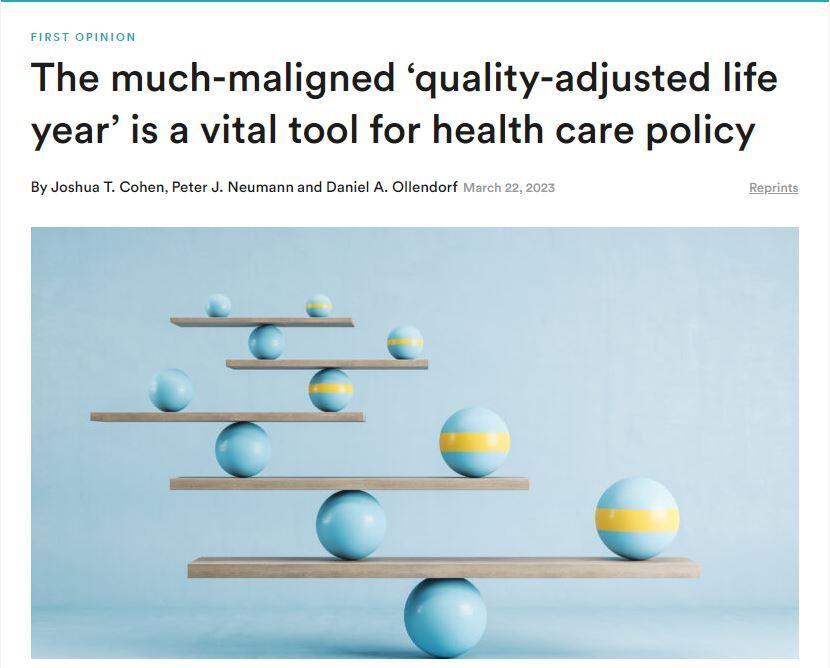Journal: STAT News First Opinion
Health policy circles have erupted in debate over a wonky administrative tool: the quality-adjusted life year (QALY) and similar metrics to value and price drugs and other health interventions. Rep. Cathy McMorris Rodgers (R-Wash.) has warned of the potential for these approaches to discriminate, arguing that “All lives are worth living. It’s unconscionable that a health care bureaucracy would so callously determine that someone’s life is worth less,” suggesting that use of QALYs discriminates against individuals with greater disease burden.
In January, McMorris Rodgers introduced the Protecting Health Care for All Patients Act, which would ban government use of QALYs. McMorris Rodgers is right to be concerned about discrimination in health care decisions. However, the Protecting Health Care for All Patients Act, which should soon head to markup, unfairly targets an important tool that can help to improve allocation of health care resources, at a fair price, for the purpose of helping everyone, including people with disabilities.
QALYs, as the name suggests, measure health in terms of both length and quality of life, including freedom from pain and ability to engage in activities. Researchers and health insurers use QALYs to estimate the benefits of a drug or other intervention, and to help determine how that intervention — given its costs, health benefits, and side effects — compares with alternatives. Analyses using QALYs can flag situations in which prices may be excessive and help prioritize interventions that deliver the most health for the cost.
For example, analyses using QALYs suggested that a several-million-dollar price tag for a treatment for spinal muscular atrophy — a rare, debilitating, and ultimately fatal disease that strikes newborns— was justified because the treatment not only saved children’s lives but could improve their development and functioning. Other studies using QALYs suggested that Paxlovid, the anti-viral treatment for Covid-19, was worth the price charged because it greatly reduces the risk of hospitalization and death. On the other hand, QALY-based analyses suggested that PCSK9 inhibitors — drugs to treat very high cholesterol levels — improved health but that their prices were excessive in light of limits of those benefits.
McMorris Rodgers and others worry that use of QALYs could lead health insurers to deny care to persons with disabilities because QALY-based analyses place a lower value on years of life gained by people who live with disabling conditions. But that’s not how QALYs are used.
Quantifying health gains can seem scary, or even repugnant. But we should not conflate use of QALYs with “rationing” of care. Difficult decisions about how much to pay for care are unavoidable. Use of QALYs simply informs decisions about maximizing people’s health given limited budgets, because this measure allows for comparison of health gains across treatments and diseases.
By placing greater value on life years with improved quality, the QALY rewards health care that improves functioning, reduces pain, and helps people with serious and disabling conditions reengage in work and other activities. It is a measure of the health gains of treatments, not a measure of the value of people.
Perhaps most importantly, analyses using QALYs are just one input in pricing and reimbursement decisions. Researchers and insurance companies also consider other inputs, such as the severity of the illness in question, the availability of alternative therapies, and benefits and risks of care that are not easily quantified. For example, because of these other considerations, the Institute for Clinical and Economic Review, a nonprofit organization that uses QALYs in its assessments of new treatments, suggested that an expensive new gene therapy for a rare, inherited retinal disease represented good “value for money,” despite its unfavorable cost-effectiveness — that is, its high cost per QALY gained.
Researchers have also responded to potential discriminatory concerns about the QALY by developing alternative measures — including the equal value life-year gained and health years in total — that place the same value on additional years of life across diseases and populations, as well as the generalized risk-adjusted QALY, which adjusts its estimates for people with lower baseline health. Cost-effectiveness results using these other measures provide yet another useful input into pricing decisions. Researchers also continue to promote consideration of attributes that conventional QALYs may not adequately capture, including improved quality of life for family care givers, improved productivity, and reduced fear of contagious disease.
Why not skip QALYs and similar metrics altogether? For one thing, banning their use would mean that health insurers that negotiate drug prices and government agencies that allocate resources cannot make “apples-to-apples” comparisons across diverse treatments and diseases. Without the QALY or its application in cost-effectiveness, health insurers might be more likely to restrict access to new, high-priced treatments based solely on their costs, even if treatments benefit individuals with disabling, severe, or life-threatening conditions. Analyses using QALYs can help insurers better identify opportunities for health-improving interventions. As an example, the Institute for Clinical and Economic Review has released the results of an initiative that calls on insurers to allow “fair access” to cost-effective treatments.
Fears about QALYs have already led to a ban on Medicare using the metric in drug price negotiations under the Inflation Reduction Act. That prohibition will limit Medicare’s ability to pursue value-based drug prices. The Protecting Health Care for All Patients Act’s outright ban on QALYs and similar measures across all federal programs would mean an unfortunate further step backward.

